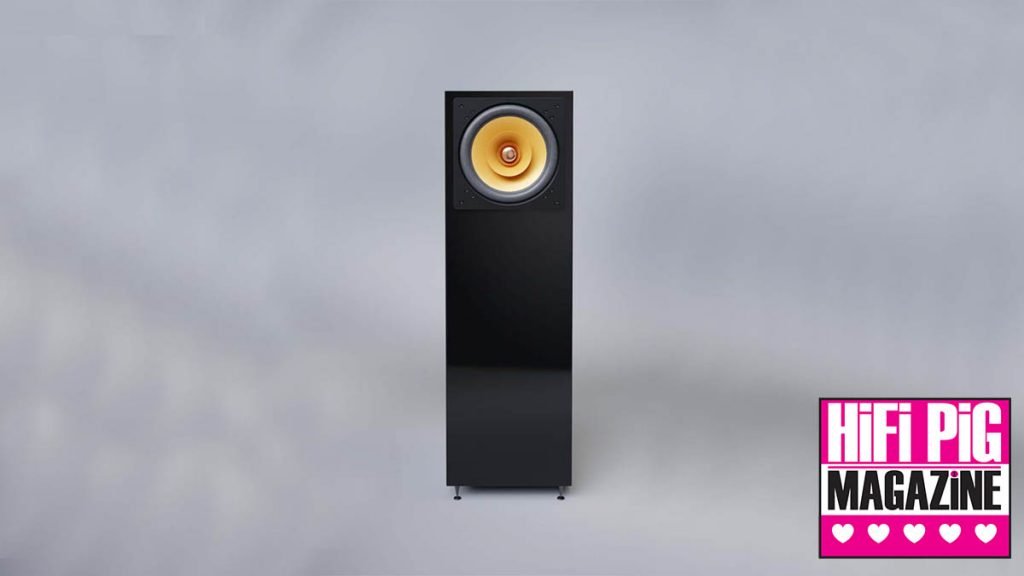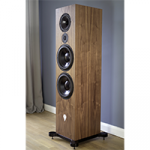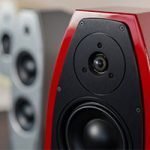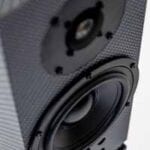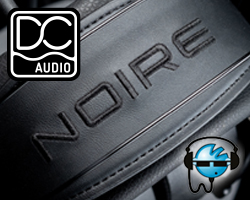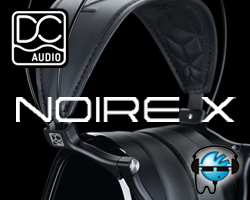CUBE AUDIO JAZZON WIDEBAND LOUDSPEAKERS REVIEW
CUBE Audio Jazzon loudspeakers are a wideband design using proprietary drivers with Tapered Quarter Wave Tube loading. Stuart Smith takes a listen for HiFi Pig.
Around fifteen years ago I was looking at building myself a pair of wide-band single-driver loudspeakers and did an inordinate amount of research into the drivers and the speaker enclosures to put them in. The first thing I found was that in the UK this kind of driver is referred to as a full-range driver, whereas in Europe they are referred to as wide-banders. Whatever you call them the concept is the same; to produce a loudspeaker that is capable of covering the “full” (or as full a) range of frequencies as possible from a single driver and without the need for bass drivers, tweeters, and, importantly, crossovers. Personally, I’ve always preferred the term wideband as it is perhaps a more accurate term for these types of loudspeakers.
The concept of a wideband loudspeaker using just one driver would seem to have great benefits over and above the use of multiple driver enclosures and the subsequent need to use often complex crossover designs, which many will argue introduce their own set of problems. However, the widebander driver is also not without its own inherent issues – the bass output is limited and thus dependent on often complex cabinet design, and the high end output is likewise limited and often augmented by the use of a whizzer cone, though I have seen commercial and DIY designs that use a separate tweeter with a very simple crossover using a single resistor or an L-Pad to attenuate the tweeter output. On the positive side, wideband drivers tend to be “faster” and more sensitive, which in turn allows for the use of low-powered amplifiers. Indeed, there is a whole sub-group of enthusiasts using “flea-powered” amplifiers (think Single Ended Triode 2A3, etc) along with widebanders of differing designs and my personal experience with them at home involved a pair of Lowther Fidelio horn-loaded cabinets allied to a wideband driver, the name of which I don’t recall, along with a 300B PSE (Parallel Single Ended) amplifier offering up about 18 Watts, which was more than adequate.
My own personal flirtation with widebanders was intense but short-lived and after about a year I found I could no longer live with that specific pair of speakers’ limitations. They were beautiful through the mid-band frequencies and I distinctly remember being floored by the way they played Fleetwood Mac’s Songbird, but I found them lacking in overall oomph in the bass department and a bit shouty in the upper frequencies. For me, it was a compromise too far, but my interest in this type of speaker has never really full dissipated and so when I was asked to take a listen to the Cube Audio Jazzon I was more than happy to do so.
CUBE AUDIO
Cube Audio is based out of Poznan in Western Poland, about halfway between Warsaw and Berlin, and produces a small range of finished loudspeakers; The Nunuphar (€16,900/pair) the Nenuphar Monitor (€16,900/pair), the Nunuphar Basis (€33,900) and the speakers we have here, the relatively new Jazzon that costs €7,990 and which represent the entry-level to the Cube Audio range of loudspeakers. However, if you are a DIY Audio enthusiast then you can buy Cube Audio drivers and build your own cabinets around them – Cube Audio even supply you with the plans relative to each driver, though many builders will look at the T&S (Thiele Small) parameters and design their own enclosures using Hornresp, WinISD, or other software applications. The Cube Audio range of drivers has three 8” drivers that range in price from €1,790/pair to €5,490 and a couple of 10” drivers that cost €2,990 for the F10 Select and from €6,690 for the 10 Neo. The Jazzon loudspeakers we have for review use the F10 Select drivers.
CUBE AUDIO F10 DRIVERS

The F10 driver used in the Jazzons is a proprietary design.
I’ll be lifting most of this from the Cube Audio website by way of accuracy and to be honest most of this will only be of interest to those looking to design their own loudspeakers around the drivers and be beyond what is relevant to those simply buying a pair of the finished loudspeakers.
Thiele / Small parameters:
Fs = 28 Hz
Re = 9,4 ohms
Le = 0.138 mH
Qt = 0.58
Qes = 0.63
Qms = 14.58
Cms = 0.72 mm/N
Mms = 30 g
Vas = 185 liters
Sd= 346 cm^2
Bl = 9.2 Tm
Xmax = +- 2.5 mm*
Xdamage = +- 6 mm
Sensitivity = 90 dB
Impedance = 10 Ohms
* Voice coil remains in 100% of the magnetic field.
Speaker dimensions:
Width / height = 260 mm
Depth = 107 mm
Weight = 6 kg
The F10 page on the Cube Audio website also includes a SPL/Frequency graph which shows the drivers to be reasonably flat up to 10K where they fall off pretty sharpish, having a bit of a hump between 60-90Hz and fall-off below 60Hz. Of course, 60Hz is not low enough for a full frequency rendition of music and this is where the cabinet design comes in to augment bass output.
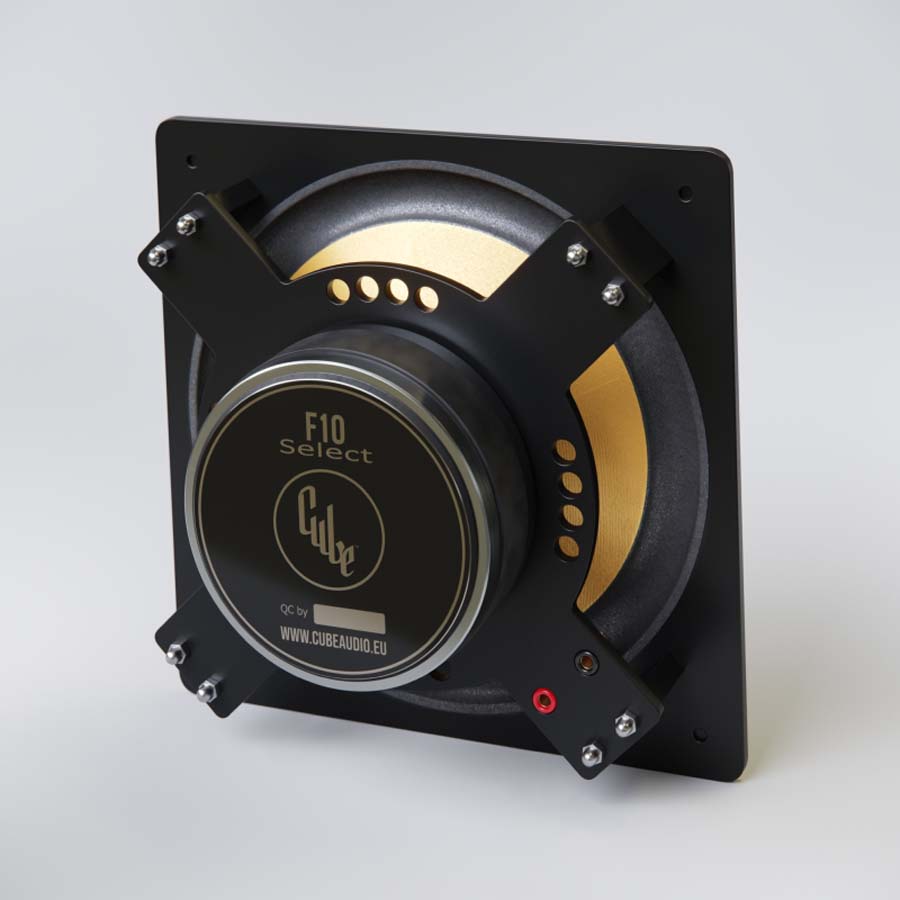
A look around the rear of the F10 drivers from Cube Audio.
CUBE AUDIO JAZZON CABINETS
Cube’s Jazzon speakers use a Tapered Quarter Wave Tube (TQWT) which is essentially a folded horn design and dates back to the 1930s and a design by Paul Voigt, though he called it a pipe rather than a tube. Wiki has this to say and it pretty much sums up the design: “The concept is that the sound emitted from the rear of the loudspeaker driver is progressively reflected and absorbed along the length of the tapering tube, almost completely preventing internally reflected sound from being re-transmitted through the cone of the loudspeaker. The lower part of the pipe acts as a horn while the top can be visualized as an extended compression chamber. The entire pipe can also be seen as a tapered transmission line in inverted form, that is, widening rather than narrowing from top to bottom.”
The finish on the speakers I was sent was really beautiful, with the driver placed at the top of the front of the cabinet and the only other accouterment being a backplate with nice binding posts. The speakers do come with a pair of spikes that fit to the front of the underside of the speakers to allow the speakers to be lifted off the floor and the opening of the TQWT to be more open to the room – these are essential to allow the full breadth of bass!

The Jazzons are not a large speaker but are quite imposing – in a good way.
Speaker dimensions are 20 x 40 x 90 cm (weight is 35Kg) and so they are a fairly big speaker, but I think they looked very smart in the smaller of our listening spaces.
The small but well-written and informative pamphlet that comes with the speakers goes into a good bit of detail (written in very understandable language) about the positioning of the speakers and the off-axis performance of the speakers. The pamphlet suggests that you experiment with toe-in, with a recommendation that 0 to 10 degrees toe in will result in the best sound. I played about with the positioning a fair bit after the speakers were run in (more on this in a moment) and found that I actually did prefer the presentation with a very slight toe-in towards the main listening position.
With regards to running in I have found it to be the case that, without exception, widebanders like to have a good run-in period. This is pretty standard practice for us at HiFi Pig Towers when we have any speaker to review, but if you do order a pair of these speakers do be aware you will need to play them without critically listening for a fair while.
SOUND QUALITY OF THE CUBE AUDIO JAZZON
For the main testing of the speakers I used a pair of 300W a channel Class D amplifiers in the form of the Merrill Audio Thor amplifiers, with associated kit being an Auralic Aries G1, LAB12 DAC, LAB 12 Pre and a LAB 12 power conditioner. Given the Jazzons are 90dB sensitive and a maximum power of 40W is recommended (impedance is quoted as being 10 Ohms) this amount of potential power could be seen as being total overkill, but they are the amps I use regularly and so the obvious ones to choose for review purposes. For my own personal entertainment, I did use them with a LAB 12 KT150 amplifier and an English Acoustics C21 and I will comment on these two experiences in passing later in the review.
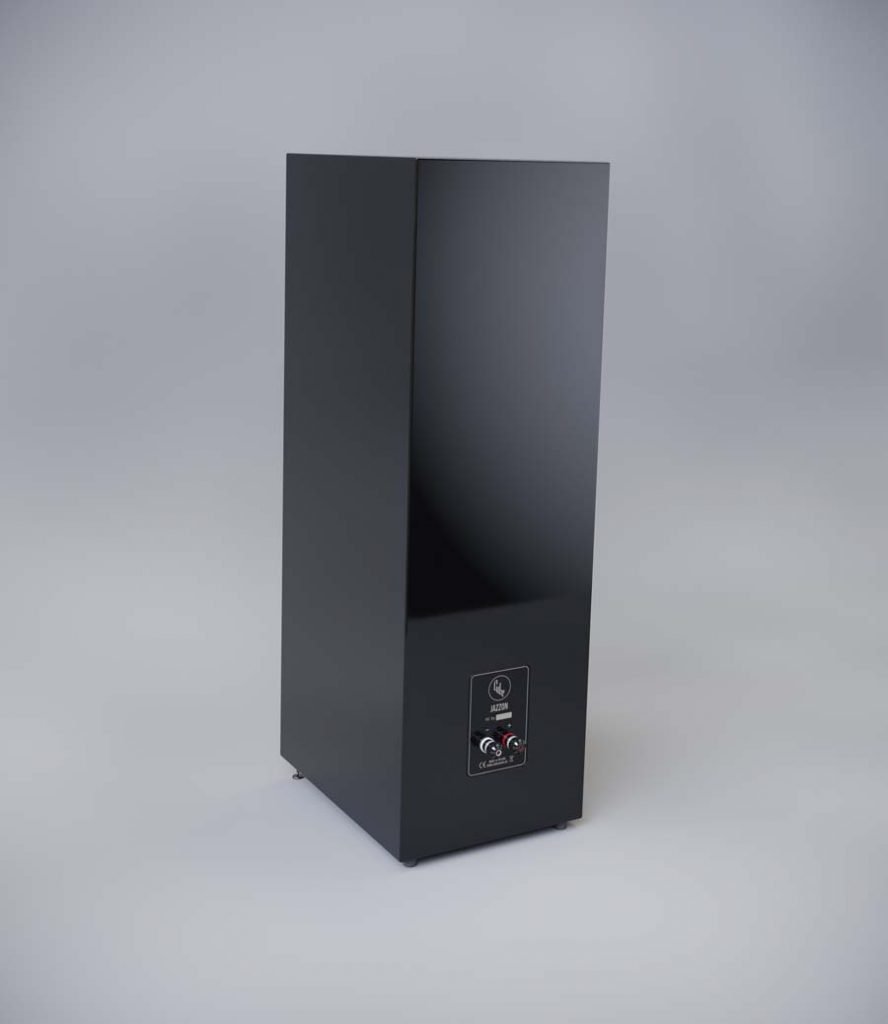
Around the back of the Jazzon loudspeakers.
Frequency response from these speakers is said to be 35Hz to 18KHz and I did think this lower frequency was ambitious, though I entered the review process, as always, with an open mind, though as with anything I did have expectations based on previous encounters with similar speakers. So, my expectations from the Jazzons were that they would be superb through the mids, a bit shouty in the higher frequencies, and a bit one-note in the very low frequencies, much as with my previous “at home” flirtations with widebanders. I expected them to be really rather nice with small-scale performances (refer back to the Fleetwood Mac track I mentioned) and really a bit lacking with techno and rock. I expected their response to be agile and direct with a point-source quality to their imaging. This latter point is one of the things I really enjoyed in my past encounters with widebanders and it is something that I look for in any loudspeaker – that feeling of immersion in the soundstage and being able to reach out and touch the music is one of the things I have always enjoyed about quality audio, right from my earliest days of experiencing it. Let’s see!
We recently installed a cinema projection screen in the listening space upstairs and I was keen to check out the sound – more by way of just seeing if everything worked properly than any serious listening. Nothing flash here, just a simple RCA from the projector to the pre and then to the amps and the pair of speakers. I was actually very surprised by the bass out of the speakers and speech sounded natural and unforced. I’d certainly be happy watching films with the Jazzons in place on a regular basis and even without a central channel speaker (I don’t do multi-speaker setups), there was no weird “where’s that coming from “ sensation to voices. Of course, this little sideshow was nothing more than a bit of a distraction, but as I said, the sound for film seemed to be more than adequate and I certainly didn’t feel the need to plug in the couple of subs we have to hand.
When playing music I’ve found, as when using horns, that the slightly different presentation takes a few moments for your brain/ears to adjust to but after a while your brain just clicks into how the speakers sound and you are drawn into the music.
The 2021 mix of The Beatles’ Let It Be (Deluxe) album has become a bit of a favourite of mine of late having a long time “take them or leave them” attitude towards the band until seeing the Peter Jackson revamp of the film made around the making of the record – I found it utterly fascinating. What became apparent listening to much of the album on the Jazzons was the really raw and pretty basic production. There’s a whole lot of crap written in reviews about this or that sounding “live” but I have to say that these speakers did give a real feeling of “being there” when listening to the “live” recording of Dig A Pony. Lennon’s vocal delivery is captured (and presented wonderfully) with you being almost able to “see” him moving to and from the microphone. The vocal is forward in the mix but it’s not forced or artificial. There is a naturalness and easy-going feeling to the music – as if the speakers aren’t having to try at all. The same is the apparent on the instruments with guitar licks sounding live and slightly overdriven, and Ringo’s drumming having a relaxed and (again) easygoing style. McCartney’s bass is there but never over-powering. I “rewind” this track half a dozen times and every time I find it truly mesmerising on the Jazzons. Across The Universe is a more “produced” track with strings and choral sounds added by Phil Spector, but the core of the track remains raw and relatively unpolished. Strummed guitar has an almost stilted feel to it which sounds like Lennon has just sat and played/sung the song in one take and is singing just for himself. It’s a delightful insight into the song and the recording and I’d love to hear a version without the added Spectorisations. As I listen to the record I read the info on Roon whilst I Me Mine is playing and it refers to the record as being “flawed and bumpy” and the Jazzons capture this perfectly – as does Jackson’s film. Not for one moment did I ever think I’d be writing about The Beatles in a review for HiFi Pig, but this record sounds perfect on the Jazzons. Everything from the rasp of the guitar solo on Let It Be to Ringo’s “I’m not really trying very hard” drumming shines and the differences in vocal delivery between Lennon and McCartney are clear to hear.
However, The Beatles are not my usual listening fodder, and whilst the album sounds organic, uncomplicated and unforced on the Jazzons it’s not the most demanding of recordings to put a pair of speakers through their paces. Much more in keeping with my usual musical fare I reach for the Fabric 66 issue of a Ben Klock mix, having travelled to Barcelona to see him perform fairly recently. The mix is predominantly of minimal(ish) techno that in turn is both distorted and dirty and crisp and clean. What I find listening to this album, as I did with a lot of the techno I listened to, is I didn’t find myself reaching for the remote to crank the volume up and was happy to listen at relatively modest volumes. The Jazzons filled the room (around 5m x 7m) very well and it was the detail within the mix and the tunes that I found myself drawn to rather than just out and out “boots ‘n cats” boom tishiness. There is detail n a lot of techno that often goes unnoticed but those that know the genre already know that it is these details that get you off on the dancefloor, and whilst the Jazzons don’t have that bass slam of a big system, they do get that detail and monitor-like feeling of the music being layered and spatial across extremely well. This point source imaging was expected, as I mentioned in my preamble, but I really could see myself getting “on one” and thoroughly enjoying these speakers in a space like this. I honestly thought I’d get to this part in the review and be chastising the Jazzons for being a bit crap in the bass department but that’s really not the case – DVS1’s Spying, along with all the noodly tops and mids, has a nagging bass line that comes across well. No, this bass is not shifting as much air as om, say, our TotalDACd100s, Audiovector R6 or Avantgarde Duos, but we are talking chalk and cheese with regards to the make-up of those speakers when compared to the Jazzons. I’m a self-identified bass-fiend but I recently had a bit of an epiphany with regards to techno music and realised that whilst that bass has to be present to have that body-music feel, it is the mids and particularly hats that draw me into a tune – this is easily achievable with the Jazzons with them separating out what can be quite busy percussive elements into parts your ears and brain can appreciate as part of the whole but individual. Effects, like on the spoken word vocal of the Octave One/Klock Terraforming track are huge in their scale and as trippy as you would like. No, you are not getting the full-on rave experience with regards to the bass presentation, but it is fast, tight and has texture. In this room it is more than adequate, though I would guess that in larger spaces (this is already far from a small space) you would want to add a sub to fill out the lower octave – personally, I had no need.
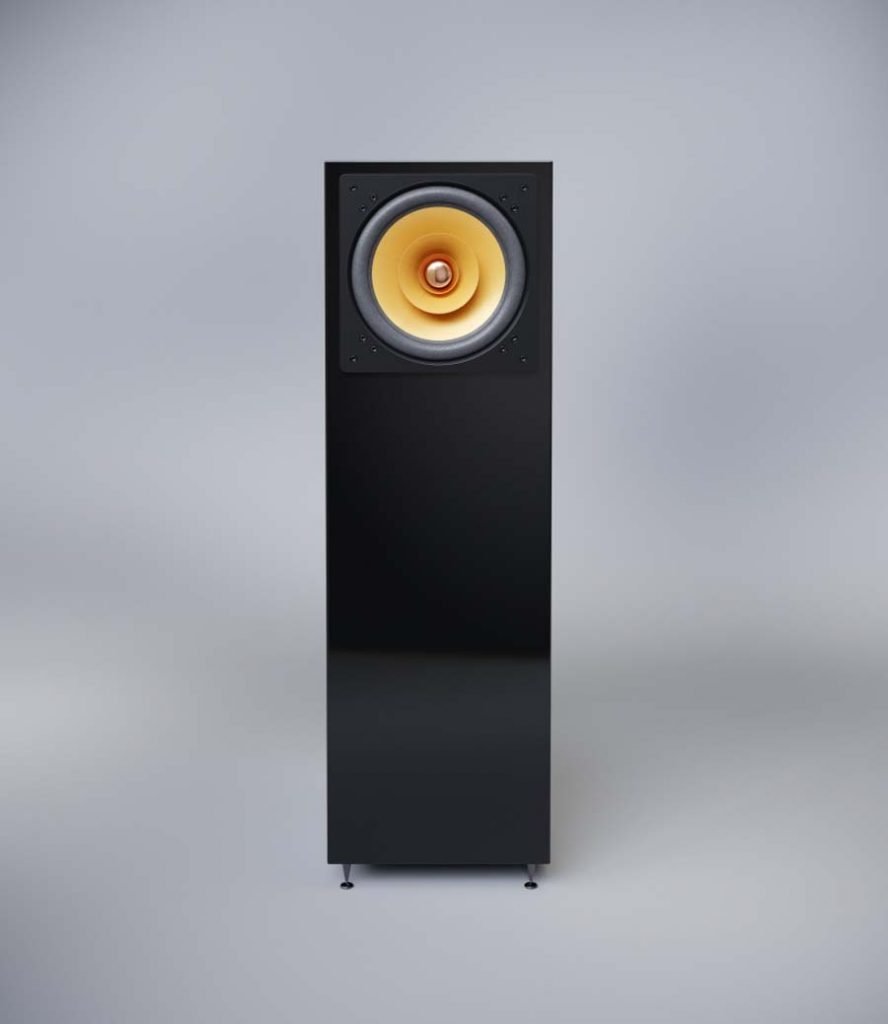
There’s no grille included but they look great without!
My guess is that at some point in their testing CUBE used a good deal of jazz music to test these speakers – I may well be wide of the mark but the name sort of gives it away. Anyway, whether it was or it wasn’t I pop on Kind Of Blue. The same kind of laidback easy-going nature of these speakers I’d heard before shines out. Everything is there and is there’s that spatial quality to the music that, for me, is so alluring. Double bass is easy to pick out of the music and drums have impact and dynamics, but it is that relaxed feeling that the speakers really get across. The alternate take of Flamenco Sketches off this album is stunning to listen to on these speakers with a real sense of the recording shining through.
I do have a play with the English Acoustics C21 and the LAB 12 KT150 amp and what is apparent is that as well as being easy to drive, the other aspect that comes across is that the Jazzons allow you to easily hear the differences in different amplifiers very easily. With this in mind, I’d suggest that, and I genuinely didn’t think I’d for one moment saying this, the CUBE Audio Jazzons would make an excellent speaker for reviewing purposes.
CONCLUSION
In my opinion, a wideband loudspeaker design lives or dies by the quality of the driver itself. The CUBE Audio driver in these speakers is a class act and makes these speakers a real joy to listen to, though there are obvious limitations, specifically in the very low bass. However, this “limitation” must be taken in context and that context is that the speakers need to work within their room-filling capabilities – in my room I had no issues! I would love to hear the speakers that are further up the CUBE Audio ladder, that’s for sure!
These are a relatively unsophisticated loudspeaker. I mean that in the nicest possible way! They are a single driver loudspeaker with a tried and tested cabinet and loading design. However, they cost just shy of €8000 which if you take at face value seems a lot of money. Sonically, for me, they deliver €8000 worth of value whatever the sophistication or otherwise of their design – and that is in no small part down to the design and build of the driver which is excellent!
The real acid test for any piece of kit that comes in for review comes when you ask yourself “could I live with thee full time and would I spend my own money on the?” and the answer with regards to the Jazzons is a pretty enthusiastic yes! They do a lot of things right and they do very little wrong.
Before I started to listen to these speakers and to write this review I expected my conclusion to be “lovely for easy-going music but a bit crap for anything dynamically taxing” but I was wrong. These are a rather lovely all-round performers that I would be happy to give house room to for personal listening when used within their limitations.
I thoroughly enjoyed my time with them and cannot wait to hear the Nunuphars. Perhaps my love of the wideband, single-driver loudspeaker concept has been rekindled.
AT A GLANCE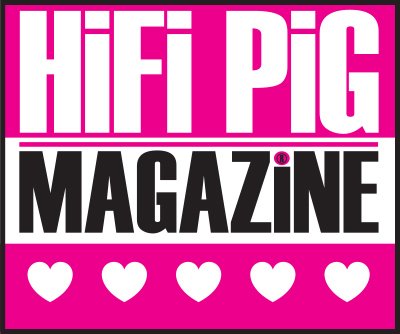
Build and Features:
Well put together and look good
Outwardly there’s not a lot to them to get wrong but what has been done has been done well by CUBE Audio
Sound Quality:
Amazing soundstaging as expected
Easy going and utterly unfatiguing to listen to for very long periods
Manage to dig small nuances of a recording out and bring it to the fore
Not at all shouty as I expected
Bass is fast, tight and articulate, though some may want to add a sub which may well defeat the object of this purist approach to loudspeaker design
Easy to drive with pretty much any amp you care to pop on the end but they will expose any inadequacies in the amp design quite easily and so I suggest partnering with quality amplification
Value For Money:
This is a tough one to all because we know that the drivers can be had for a smidge off €3,000 and that means that you are paying €5K for the cabinets and labour. However, for €8,000, for me, they do still represent a reasonable investment, though others, I’m sure will be unable to get over that cost differential. If that’s the case, then buy the drivers and build the cabs yourself and save however much, though I’m sure not everyone is going to have the skills to finish their speakers to such a high standard as the finished article we have here!
We Loved:
Nice and purposeful looking
Detailed though the frequency spectrum, particularly strong in the mids and tops
The bass is tight, though some will want a speaker that goes lower and moves more air
Very easy to listen to
We Didn’t Love So Much:
The price differential between the finished speaker and the component drivers may put some off
They don’t move as much air as some of our other loudspeakers
Price: €7,990
Elevator Pitch Review: Made in Poland, the CUBE Audio Jazzon loudspeakers cost €7,990 and use a single wideband driver with no crossover. To extend the bass response they use a Tapered Quarter Wave Tube. Sonically they deliver what I would consider being an accurate portrayal of music and, whilst they are best suited to acoustically recorded music, they certainly deliver the goods on electronic program too. They are hugely detailed through the mids and tops and whilst the bass response will leave some wanting, I found them to be more than satisfactory, delivering as they do a tight and speedy rendition of bass notes. Partner with quality electronics!

Stuart Smith














































